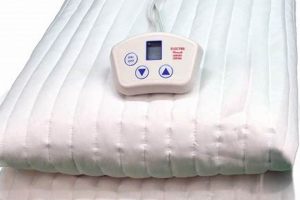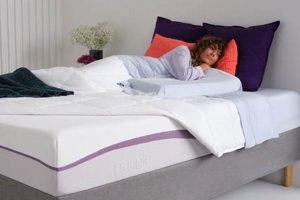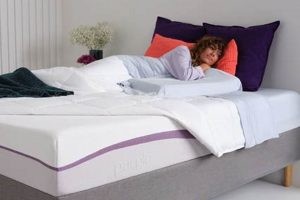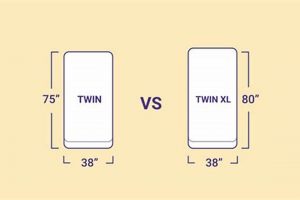A longer version of the standard single bed, a twin extra-long sleeping surface provides additional length suitable for taller individuals, commonly found in college dormitories. These sleeping solutions utilize polyurethane or memory materials to conform to the sleeper’s body, offering pressure relief and support.
The extended length caters to the needs of adolescents and adults exceeding average height, ensuring a comfortable and restful night’s sleep. The composition allows for even weight distribution, minimizing pressure points and promoting proper spinal alignment. This type of bed offers a practical and space-efficient solution for smaller living spaces while accommodating individual comfort requirements. Originally developed for institutional settings, it’s now a growing choice in residential spaces.
The subsequent sections will explore the various types of materials used in these beds, discussing their specific properties and benefits, as well as factors to consider when selecting the optimal choice for individual needs and preferences.
Guidance on Selection and Care
Proper selection and maintenance ensure optimal performance and longevity. Consider the following points before purchasing and during ownership.
Tip 1: Prioritize Density. Higher density materials offer greater support and durability. Investigate density specifications to gauge potential lifespan and resistance to sagging.
Tip 2: Evaluate Firmness. Firmness is subjective; consider sleeping position and body weight. Side sleepers typically benefit from softer options, while back and stomach sleepers often require firmer support.
Tip 3: Inquire About Certifications. Look for certifications such as CertiPUR-US, which indicates low VOC emissions and absence of harmful substances.
Tip 4: Invest in a Quality Protector. A waterproof and breathable protector shields against spills, stains, and dust mites, extending the product’s life.
Tip 5: Rotate Regularly. Rotating the mattress every few months promotes even wear and prevents indentations. Follow manufacturer instructions for optimal rotation frequency.
Tip 6: Utilize Proper Support. Ensure the bed frame provides adequate support. Slatted frames should have slats spaced no more than a few inches apart to prevent sagging.
Tip 7: Understand the Warranty. Carefully review the warranty terms and conditions. Note any specific requirements for maintaining warranty coverage, such as using a recommended bed frame.
Selecting a high-quality material and adhering to these maintenance practices maximizes comfort, support, and the life of your twin extra-long bed. These actions ensure that the investment yields long-term benefits.
The following sections will delve into comparing different material types available in the market. The data will help the reader make an informed decision.
1. Dimensions
Dimensions, specifically the 38-inch width and 80-inch length, define a twin XL foam mattress and distinguish it from standard twin sizes. These measurements directly impact suitability for individuals, particularly taller adolescents and adults, providing adequate space to prevent feet from hanging off the edge. The specified length addresses a common need in dormitories and smaller living spaces where maximizing floor space is crucial. Deviation from these standardized dimensions renders the product incompatible with designated bed frames and fitted sheets, causing practical issues and decreased user satisfaction.
Consider the scenario of a college student in a compact dorm room. The standardized 80-inch length accommodates their height without requiring a larger bed size, which would further constrict the living area. Furthermore, precise dimensions facilitate easy online ordering and ensure compatibility with readily available accessories, streamlining the purchasing process. Incorrect dimensions, on the other hand, could lead to returns, exchanges, and dissatisfaction with online retailers offering products with misleading measurements.
In summary, the fixed dimensions of a twin XL foam mattress are not arbitrary; they are functionally determined to meet specific spatial requirements and cater to particular user groups. Understanding these dimensional constraints is essential for manufacturers, retailers, and consumers to ensure proper fit, optimal comfort, and overall product satisfaction. Disregard for the defined dimensions has direct consequences on usability and represents a significant obstacle to fulfilling the intended purpose of the product.
2. Density
Density, measured in pounds per cubic foot (lbs/ft), is a critical attribute of a twin XL foam mattress, directly influencing its support, durability, and overall lifespan. Higher density implies more material packed into a given volume, leading to increased resistance to compression and a reduced likelihood of sagging or developing body impressions over time. For instance, a memory foam option with a density of 5 lbs/ft will generally provide superior support and last longer than one with a density of 3 lbs/ft, all else being equal. The practical effect of selecting a low-density model is a shortened lifespan and compromised support, potentially leading to discomfort and the need for premature replacement.
Different foam types exhibit varying density ranges. Conventional polyurethane foam typically has lower densities than memory foam or latex. Within memory foam varieties, higher density formulations tend to conform more closely to the body’s contours, offering enhanced pressure relief. However, increased density can also contribute to heat retention. Therefore, selecting a twin XL foam mattress requires a balanced consideration of density in relation to other factors, such as ventilation and individual comfort preferences. For example, an athlete may prioritize high-density support for muscle recovery, whereas someone with circulatory issues may prefer lower density for improved airflow.
In conclusion, density is an indispensable factor in evaluating the quality and longevity of a twin XL foam mattress. It directly impacts support, durability, and pressure relief capabilities. While higher density generally indicates superior performance, consideration must be given to individual needs and preferences, as well as other material properties. A thorough understanding of density empowers consumers to make informed decisions and invest in a sleeping surface that provides both comfort and long-term value.
3. Firmness
Firmness, a tactile characteristic perceived upon initial contact with a twin XL foam mattress, critically influences spinal alignment, pressure distribution, and overall sleep quality. Its selection necessitates aligning personal preference with physiological requirements to optimize restorative sleep.
- Scale Definition
Firmness typically exists on a scale ranging from extra-soft to extra-firm, with numerical representations occasionally employed to denote specific levels. Extra-soft options yield significantly under pressure, while extra-firm offerings provide minimal give. The optimal choice depends on individual body weight, preferred sleeping position, and any pre-existing musculoskeletal conditions. Misalignment between firmness level and these factors can exacerbate discomfort and disrupt sleep cycles.
- Sleeping Position Influence
Sleeping position dictates firmness requirements. Side sleepers generally benefit from softer surfaces that conform to the shoulders and hips, promoting spinal alignment. Back sleepers often require medium-firm options that support the natural curvature of the spine, preventing excessive sinking. Stomach sleepers typically need firmer support to avoid hyperextension of the lower back. Deviations from these recommendations can result in pain and compromised sleep quality.
- Body Weight Consideration
Body weight correlates directly with firmness needs. Individuals with lower body weights may find softer options sufficiently supportive, while those with higher body weights often require firmer surfaces to prevent excessive compression and maintain spinal alignment. Choosing a mattress that is too soft for a heavier individual can lead to sagging and discomfort, while selecting one that is too firm for a lighter individual may result in pressure points and restless sleep.
- Material Interaction
Firmness perception is influenced by the foam’s material composition. Memory foam typically offers a contouring feel and can be found in various firmness levels. Latex provides a more responsive and buoyant feel, generally perceived as firmer than comparable memory foam. Polyurethane foam varies widely in firmness depending on its density and formulation. Combining different foam layers allows manufacturers to create customized firmness profiles that cater to specific needs.
The interplay between firmness and individual needs underscores the importance of thorough consideration during the selection process. By accounting for sleeping position, body weight, and material properties, individuals can optimize comfort, support, and sleep quality when choosing a twin XL foam mattress.
4. Composition
The composition of a twin XL foam mattress dictates its performance characteristics, including support, durability, temperature regulation, and comfort. Material selection directly influences the sleeper’s experience, determining whether the mattress adequately conforms to the body, maintains a comfortable temperature, and provides sufficient long-term support. For instance, a mattress primarily composed of low-density polyurethane foam may offer an initial soft feel but will likely exhibit premature sagging and inadequate support, leading to discomfort and reduced sleep quality. Conversely, a blend incorporating high-density memory foam or latex will provide enhanced support and pressure relief, potentially improving sleep and reducing back pain.
The impact of composition extends beyond immediate comfort. Material choices affect the mattress’s resistance to allergens and microbial growth. Some foam types are inherently hypoallergenic and resistant to dust mites, making them suitable for individuals with allergies or asthma. Open-cell foam structures, often found in latex or specialty memory foam, promote airflow and reduce heat retention, mitigating the risk of overheating during sleep. Manufacturers frequently combine different foam layers to achieve specific performance goals. A common configuration includes a high-density base layer for support, a comfort layer of memory foam for pressure relief, and a breathable top layer to regulate temperature. The proportions and properties of these layers are critical in determining the mattress’s overall functionality.
Ultimately, understanding the composition of a twin XL foam mattress is paramount for making an informed purchase. The specific materials used and their arrangement within the mattress directly impact its performance, longevity, and suitability for individual needs. By considering the properties of various foam types and their potential benefits and drawbacks, consumers can select a mattress that provides optimal comfort, support, and value. The challenge lies in deciphering marketing claims and focusing on verifiable specifications, such as foam density and certification standards, to ensure the chosen mattress aligns with their specific requirements.
5. Support
In the context of a twin XL foam mattress, “support” refers to the mattress’s ability to maintain proper spinal alignment, distribute weight evenly, and minimize pressure points. Adequate support is paramount for restful sleep and preventing musculoskeletal issues.
- Spinal Alignment Maintenance
A supportive twin XL foam mattress prevents the spine from sagging or arching unnaturally during sleep. Proper alignment reduces strain on back muscles and ligaments, mitigating the risk of back pain and stiffness. For example, a mattress that is too soft allows the hips to sink excessively, misaligning the spine, whereas a mattress that is too firm fails to conform to the body’s natural curves, creating pressure points and discomfort.
- Weight Distribution
Effective support involves distributing body weight evenly across the mattress surface. Uneven distribution can lead to localized pressure points, particularly at the shoulders, hips, and knees. Memory foam, known for its contouring properties, excels at distributing weight and minimizing pressure. A twin XL foam mattress with poor weight distribution may cause tossing and turning as the sleeper attempts to find a comfortable position, disrupting sleep cycles.
- Edge Support
Edge support refers to the firmness and stability of the mattress edges. Adequate edge support prevents the sleeper from rolling off the mattress and maximizes the usable sleeping surface. Reinforced edges are particularly beneficial for individuals who sleep near the edge or require assistance getting in and out of bed. Lack of edge support can lead to a feeling of instability and reduce the perceived size of the mattress.
- Layered Construction Impact
The internal structure of a twin XL foam mattress, including the density and arrangement of foam layers, plays a crucial role in providing adequate support. A high-density base layer is essential for preventing sagging and maintaining long-term support, while comfort layers of memory foam or latex provide cushioning and pressure relief. The arrangement and interaction of these layers determine the overall support characteristics of the mattress. Inadequate layering can result in a sleeping surface that lacks both support and comfort, undermining the intended benefits of a foam mattress.
In essence, the support offered by a twin XL foam mattress is a multifaceted characteristic involving spinal alignment, weight distribution, edge stability, and internal construction. Understanding these elements enables informed decision-making when selecting a mattress that promotes restful sleep and long-term musculoskeletal health.
6. Longevity
Longevity, defined as the lifespan and sustained performance of a twin XL foam mattress, represents a critical factor for consumers. A mattress’s ability to maintain its support, comfort, and structural integrity over time directly impacts its cost-effectiveness and overall value.
- Material Density and Degradation
Foam density is a primary determinant of longevity. Higher-density foams exhibit greater resistance to compression and deformation, thereby mitigating sagging and the development of body impressions. Low-density foams degrade more rapidly, leading to a diminished lifespan and compromised support. For instance, a twin XL foam mattress with a high-density memory foam core may retain its shape and support for 7-10 years, while a low-density polyurethane foam option might only last 3-5 years before requiring replacement.
- Construction and Layering Techniques
The construction methods employed and the layering of different foam types significantly influence longevity. Mattresses constructed with reinforced edges and durable base layers are better equipped to withstand daily use and maintain their structural integrity. Proper layering, such as combining a high-density support core with a comfort layer, ensures both support and pressure relief over an extended period. Conversely, a poorly constructed mattress with inadequate layering may exhibit premature wear and tear.
- Usage Patterns and Weight Distribution
Usage patterns and the weight distribution of the sleeper contribute to the overall lifespan of a twin XL foam mattress. Mattresses subjected to heavy or uneven weight distribution are more prone to localized compression and sagging. Regularly rotating the mattress and using a supportive bed frame can help to distribute weight evenly and prolong its lifespan. A single sleeper, for instance, may experience less wear and tear on a twin XL foam mattress than two sleepers sharing the same surface.
- Environmental Factors and Maintenance
Environmental factors, such as humidity and temperature, as well as maintenance practices, can impact the longevity of a twin XL foam mattress. Exposure to excessive moisture can promote microbial growth and foam degradation, while extreme temperatures can affect foam elasticity. Using a waterproof mattress protector, regularly cleaning the surface, and avoiding direct sunlight can help to preserve the mattress and extend its lifespan. Neglecting these maintenance practices can accelerate deterioration and necessitate early replacement.
These facets collectively underscore that the longevity of a twin XL foam mattress is a function of material quality, construction techniques, usage patterns, and environmental factors. Consumers should carefully consider these elements when selecting a mattress to ensure long-term performance and value, aligning their choice with individual needs and lifestyle.
Frequently Asked Questions
This section addresses common inquiries regarding twin XL foam mattresses, providing objective information to assist in informed decision-making.
Question 1: What distinguishes a twin XL foam mattress from a standard twin size?
The primary distinction lies in length. A twin XL foam mattress measures 80 inches in length, compared to the standard twin’s 75 inches. This additional length caters to taller individuals, particularly adolescents and adults.
Question 2: How does foam density affect the performance of a twin XL foam mattress?
Foam density, measured in pounds per cubic foot (lbs/ft), directly correlates with support, durability, and longevity. Higher density foams provide greater resistance to compression and are less prone to sagging over time.
Question 3: What factors should be considered when selecting the firmness level of a twin XL foam mattress?
Firmness selection should align with sleeping position, body weight, and individual preferences. Side sleepers generally benefit from softer surfaces, while back and stomach sleepers often require firmer support. Body weight also influences the perceived firmness and support.
Question 4: Are twin XL foam mattresses suitable for individuals with allergies?
The suitability depends on the foam composition. Certain foam types, such as latex and some memory foams, exhibit inherent hypoallergenic properties. Look for certifications indicating low VOC emissions and the absence of harmful substances.
Question 5: How can the lifespan of a twin XL foam mattress be extended?
Longevity can be enhanced through proper maintenance practices. These include using a waterproof mattress protector, rotating the mattress regularly, ensuring adequate support from the bed frame, and avoiding exposure to extreme temperatures or humidity.
Question 6: What are the potential drawbacks of a twin XL foam mattress?
Potential drawbacks include heat retention (particularly with some memory foam formulations), potential off-gassing (initial odor release), and the difficulty in moving or handling heavier, high-density models.
In summary, selecting a twin XL foam mattress requires careful consideration of dimensions, density, firmness, composition, and individual needs to ensure optimal comfort, support, and long-term satisfaction.
The subsequent section will explore specific brands and models of twin XL foam mattresses currently available on the market, providing a comparative analysis to aid in the selection process.
Conclusion
The preceding analysis has comprehensively examined various facets of the twin XL foam mattress, including dimensions, density, firmness, composition, support, and longevity. Each of these factors contributes significantly to the overall suitability of the product for individual needs and preferences. It has been shown how the selection of appropriate materials and construction techniques directly influences the performance and lifespan of these mattresses. The importance of proper maintenance and usage patterns in preserving the integrity of the product has also been underscored.
Ultimately, informed purchasing decisions regarding a twin XL foam mattress necessitate a thorough understanding of these interrelated elements. Consumers are encouraged to critically evaluate product specifications and align their selection with specific requirements to ensure optimal comfort, support, and long-term value. Failure to adequately assess these characteristics may result in compromised sleep quality and premature product failure, undermining the intended benefits of a foam sleeping surface.


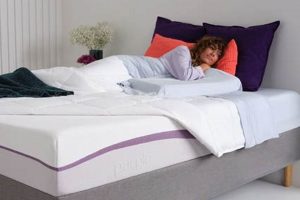
![Best Twin XL Bed Frame & Mattress [Guide] Organic & Natural Mattress Buyer’s Guide: Non-Toxic Sleep Solutions Best Twin XL Bed Frame & Mattress [Guide] | Organic & Natural Mattress Buyer’s Guide: Non-Toxic Sleep Solutions](https://mattressworldpa.com/wp-content/uploads/2025/07/th-843-300x200.jpg)
